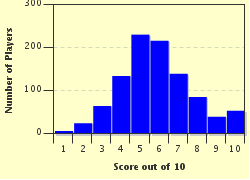Quiz Answer Key and Fun Facts
1. Marrying on Whit Sunday in 1152, the bride was 11 years older than her groom. Although both were high born, the wedding was a quiet affair, possibly because it took place only 6 weeks following the annulment of the bride's first marriage to a very high born individual. Who were the happy couple?
2. On 24th April 1567, a certain lady was allegedly abducted, carried off to Dunbar Castle and allegedly raped by the man who, to save her honour, became her third husband. Mystery surrounds the truth of this bedding. Who is the lady and who did she marry less than a month later?
3. On the morning of 9th April, 1747, an 80 year old nobleman, once known as "the most devious man in Scotland" was helped up onto the scaffold on Tower Hill, and upon observing the crowds gathered to witness his execution, exclaimed, "God save us, why should there be such a bustle about taking off an old grey head that cannot get up three steps without three bodies to support it?" This was the last execution by beheading held in Britain. Who was the victim?
4. On 29th July, 1981, Charles, Prince of Wales married Lady Diana Spencer in St. Paul's Cathedral, London. He was 32 years old and she was 19 years old.
5. Last words, to the headsman, "I pray you, dispatch me quickly." "Aye, madam." "You will not take it off before I lay me down?" "Nay, my lady, kneel you down upon the straw." She kneels, and ties a kerchief over her eyes and reaches for the block which she cannot find. "Where is it? What shall I do? Where is it?" A spectator takes pity on her and guides her hands to the block. "Into your hands I commend my spirit." And she is dispatched quickly as requested. Who is this pathetic victim?
6. On 3rd June, 1937 HRH The Duke of Windsor married the woman he loved at the Chateau de Cande, near Tours, France. The Duke was extremely annoyed about certain aspects of the wedding he'd given up a throne to achieve. What was he angry about?
7. The British Parliament refused to pay the debts of George, Prince of Wales, son of King George III, unless and until the Prince married and begat an heir.
George gave in and agreed to marry Princess Caroline of Brunswick. Upon first meeting his bride-to-be, what did George say?
8. Rhea Silvia was the daughter of King Numitor of Alba Longa who lost his throne to his brother Amulius. To prevent any descendants of Numitor, Rhea Silvia was forced to become a Vestal Virgin and her brother was murdered for the same reason. Rhea Silvia caught the lustful interest of the god Mars and was raped by him, resulting in the birth of the twins, Romulus and Remus.
9. On 20th November, 1947, a pretty, dark-haired young woman married a tall, good-looking blonde naval officer. Over the years they produced three boys and a girl, and suffered the usual ups and downs of any married couple. Which couple can we say lived fairly happily ever after?
10. On 6th July, 1535, a gentlemen condemned to die for high treason kissed his executioner on the cheek and joked with him that since his beard had done no wrong it did not deserve the axe. Laying his head on the block, he carefully made sure his beard would not be cut. Who went to his martyr's death so cheerfully?
Source: Author
JaneofGaunt
This quiz was reviewed by FunTrivia editor
bloomsby before going online.
Any errors found in FunTrivia content are routinely corrected through our feedback system.

